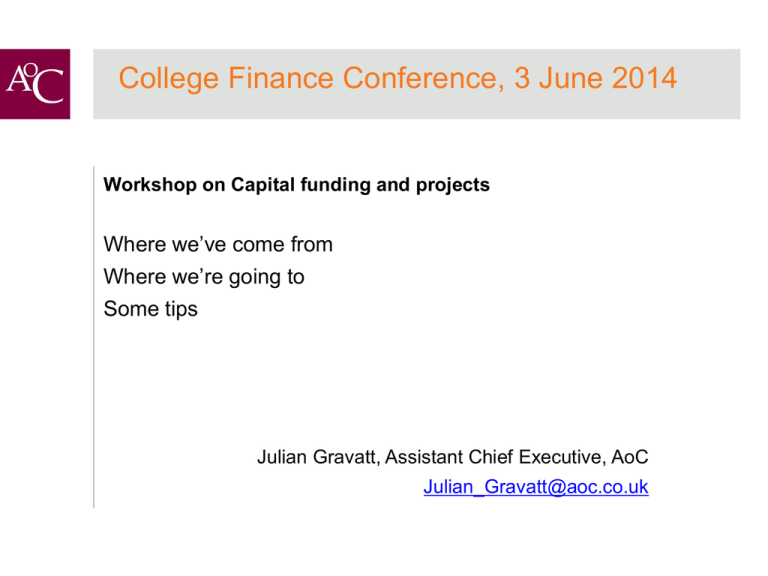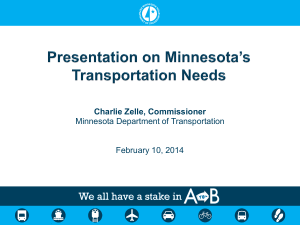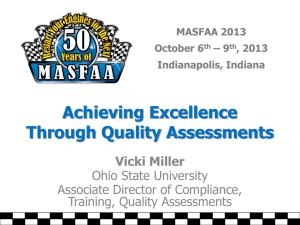AoC Finance 3 June 2014 Capital
advertisement

College Finance Conference, 3 June 2014 Workshop on Capital funding and projects Where we’ve come from Where we’re going to Some tips Julian Gravatt, Assistant Chief Executive, AoC Julian_Gravatt@aoc.co.uk College capital projects Some permanent characteristics A College success over the last 20 years College ownership and direction of projects Mixed funding model (unlike schools) Grant + Cash + Asset sales + Loans New buildings customised for each College Lots of extensions and second buildings Capital expenditure also used for IT and equipment Capital funding up to 2009 Building Colleges for the Future Government funded comprehensive College re-development Colleges used to bid for funds from LSC One by one bid assessment Three tests: education, property, value for money % grant calculated on basis of assessment of College finances In 2009, LSC unable to fund projects it had approved Now a matter of history but some colleges still not recovered A number of colleges have good buildings in place Capital funding 2010 to 2015 Short-term funding Coalition allocated money for Colleges in May 2010 budget An extra £750 mil allocated to FE Colleges 2010 to 2015 Sixth form college funding handled separately by EFA Lots of funds (ERG 1,2 and 3, CCIF, SICF, CCF etc) Funding assumption has been 33% grants Additional funding based on financial health assessment Bids assessed in groups using a scoring system Research on college capital projects carried out in 2012 College capital investment strategy (November 2012) Some dates Positive impact of capital investment: More student numbers Higher performance & satisfaction Increased employer engagement Income generation Economic regeneration 2013-15 priorities Benefits to learners/economic growth Building condition Value for money Capital reference group College involvement in the details Advisory Group of Principals, FDs, SFA, BIS and EFA Group set up in 2009 at request of then Secretary of State AoC provides the secretariat. Minutes on AoC website Advice to officials on practicalities Final decisions on policy & bids made by Minister & SFA CEO Some things are non-negotiable, for example - Annual budgets & spending - Use of bids - Requirement to fit policy priorities Outcomes Lots of lessons in last 12 months Bidding didn’t work well initially, resulting in a bottleneck. Two stage process (EOI, approval). Max grant £10 mil. Projects have to be ready by September 2015. 95 projects awarded £433 mil in 2013-15 via CCIF. SFA funding supports £821 mil in spending (ie average 53%). There was an underspend in 2013-14 . SFA allocated £114 mil in 2013-14 , £319 mil in 2014-15. SFA spent £5 mil via SICF fund on equipment. 16 projects. SFA introduced College Condition Fund (CCF) in December. £48 mil to 114 colleges with worse buildings. Outcomes Those lessons It pays to write a good bid. It pays to be quick and to have a project on the shelf. Bids always need to have something new. Possibly a mismatch between different objectives. Largest % grants go to those with weakest finances Lead times cannot be compressed easily. Bidding systems + annual budgets = underspends. Austerity means responsibility sits with governing bodies. Colleges need to work out their own priorities. Some dates The Good News £330 mil allocated for FE/Skills Capital in 2015-16 Vince Cable promised a second year (2016-17) in November The Not-so-good news A completely new system for spending the money Eligibility widened from colleges to “skills” 11 months on, not a lot of information about the process Risk that budget could be pulled following election Local enterprise partnerships Single Local Growth Fund £330 mil 2015-16 for Skills Capital 39 LEPs Different sizes and structures LEP Economic Plans (March 2014) LEP Growth Deals (Summer 2014) Cabinet office, BIS and CLG Unanswered questions LEP process unclear What will SFA role be in future Capital Projects? Who will advise LEPs on capital/estate issues? How will bids be assessed? How will match funding requirements be handled? Will LEPs divert money to other things? How will colleges address serious maintenance issues? How will need for 16-19 capital projects be addressed? DFE capital funding A game of two halves New Coalition government cancelled the BSF programme DFE’s capital budget cut by 50% in 2010 spending review Priority was given to new free schools Schools places crisis became pressing. Money found in 2012 DFE now works with Councils to plan places Major school capital budget (£3bil/year from 2015 to 2020) Current priority is new primary / secondary places. Argument over free schools –vs-basic need in May 2014 Money can be used for new 16-19 schools, UTCs etc £60 mil/year for Sixth form colleges. £30 mil for growth Capital funding 2010 to 2015 2015 to 2020 Capital budget cut by 50% in 2010 £5,000 bil in total for new places Some money routed via councils £1,500 mil for new free schools £21,000 mil budget for 6 years DFE 16-18 c£65 mil/year SFC buildings £30 mil/year 16-18 growth Some new 16-19 free schools Nothing yet earmarked SFA £600 mil spent on pre-2010 projects £750 mil via ERG, CCIF, CCF etc May yet have a role BIS (outside SFA) £1,000+ mil for Research £330 mil/year for 2 years via LEPs £80 mil in 2015-16 for national projects DFE Schools Student loans capitalised £2,000 mil for new school places £2,000 mil for school rebuilding Capital projects Colleges need to make their own decisions on projects Investment can increase income, rationalise space, reduce costs & meet employer needs. Why else do a project? Government has been a good funder in the past but is now unreliable and runs one-year budgets LEPs now hold the ring and may be allies in making projects happen Worth having bid-ready projects and a property strategy











